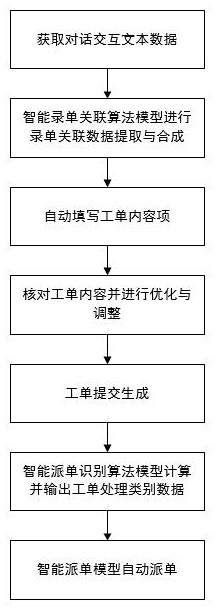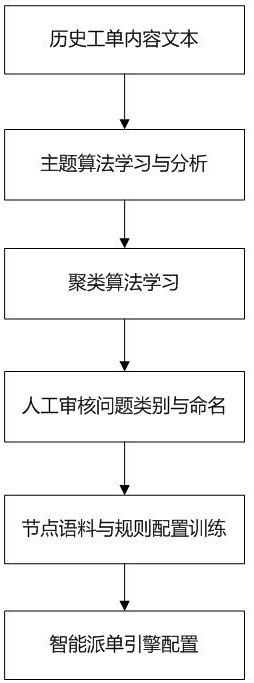Automatic order recording and intelligent order sending method of customer service system
A customer service system and intelligent technology, applied in character and pattern recognition, natural language data processing, instruments, etc., can solve problems such as category limitation, high difficulty of manual order dispatching, and low efficiency of order recording, and achieve sufficient prediction conditions and follow-up quality. The effect of checking convenience and improving filling quality
- Summary
- Abstract
- Description
- Claims
- Application Information
AI Technical Summary
Problems solved by technology
Method used
Image
Examples
Embodiment 1
[0056] A method for automatically recording orders and intelligently dispatching orders in a customer service system, comprising:
[0057] Step 1. Obtain dialogue interaction text data;
[0058] Step 2. Extracting and synthesizing data associated with the entry through the intelligent entry-entry association algorithm model;
[0059] Step 3. Automatically fill in work order content items;
[0060] Step 4. Check the content of the work order and make optimization and supplementary adjustments;
[0061] Step 5. Work order submission and generation;
[0062] Step 6. The work order is entered into the intelligent dispatch order recognition algorithm model, and the work order processing category data is calculated and output;
[0063] Step 7: Enter the work order processing category data into the smart dispatch model for automatic dispatch.
Embodiment 2
[0065] A method for automatically recording orders and intelligently dispatching orders in a customer service system, comprising:
[0066] Step 1. Obtain dialogue interaction text data;
[0067] Specifically: the system obtains the text data of the dialogue between the user of the proposed work order and the customer service agent, the voice access user, obtains the text data after real-time voice transcription, and the online customer service obtains the dialogue text data;
[0068] Step 2. Extracting and synthesizing data associated with the entry through the intelligent entry-entry association algorithm model;
[0069] Specifically: input the dialogue text data obtained in step 1 into the intelligent record-recording association algorithm model, and extract and synthesize the record-recording associated data; the extraction of associated data includes but is not limited to: "customer name, contact number, province, writing card Channel number, access method, product, order...
Embodiment 3
[0081] Step 1. Obtain dialogue interaction text data;
[0082] Step 2. Extracting and synthesizing data associated with the entry through the intelligent entry-entry association algorithm model;
[0083] The process of the intelligent recording list association algorithm model includes:
[0084] 21) Perform data cleaning on historical work order data, select a sufficient number of standard samples to form a historical sample set;
[0085] 22) Use natural language processing technology to process work order data, segment unstructured text, calculate word frequency and form word vectors;
[0086] 23) For the work order samples that have formed word vectors and formatted, use machine learning algorithms to classify and train products, purchase channels, problem descriptions, user appeals and other information. After multiple trainings and optimizations, the standardized record classification is finally obtained template;
[0087] 24) When there is a new customer consultation, ...
PUM
 Login to View More
Login to View More Abstract
Description
Claims
Application Information
 Login to View More
Login to View More - R&D
- Intellectual Property
- Life Sciences
- Materials
- Tech Scout
- Unparalleled Data Quality
- Higher Quality Content
- 60% Fewer Hallucinations
Browse by: Latest US Patents, China's latest patents, Technical Efficacy Thesaurus, Application Domain, Technology Topic, Popular Technical Reports.
© 2025 PatSnap. All rights reserved.Legal|Privacy policy|Modern Slavery Act Transparency Statement|Sitemap|About US| Contact US: help@patsnap.com



